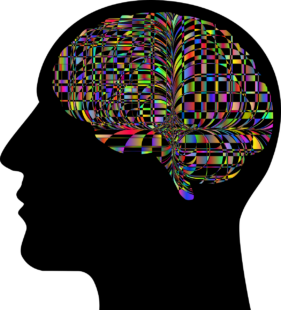What to Do When You’re Feeling Anxiety and You Don’t Know Why
Marty Robinette
In the eighties and nineties, I had the privilege of teaching an introductory course to high school students on psychology. It was a lot of fun because high schoolers have a natural interest in psychology and so much was being learned about the brain during that time. I clearly remember the belief that brain growth and neuron connections would take place up to the late teens, and that was it.
 You got what you got at that point. Much of what we knew about the brain’s functioning was from brain damage through the location of injuries, strokes, and examination of cadavers. Over time we were able to get a pretty good idea as to where things were in the brain, but it was just the beginning.
You got what you got at that point. Much of what we knew about the brain’s functioning was from brain damage through the location of injuries, strokes, and examination of cadavers. Over time we were able to get a pretty good idea as to where things were in the brain, but it was just the beginning.
As things progressed through those decades and into the 2000s, some amazing discoveries were made. With the help of digital technology, we can watch the brain at work. We can see thought processes in real-time, emotions as they are experienced, and the actual locations of memories of sights, sounds, and smells.
One of the most amazing discoveries was the fact that the brain grows and can be changed. We call this neuroplasticity, and it has fundamentally changed how we approach traumatic brain injury, psychological trauma, and other mental health issues.
The brain is a mass of nerve cells called neurons and those neurons connect to each other and produce thoughts, images, sounds, and so much more in our heads. New connections can be made from one neuron to another throughout our adult life and we can shift our thinking processes from negative outcomes to more positive ones.
What is anxiety?
We experience fear when we are presented with a real danger or threat of danger in our lives. Anxiety happens when we imagine a real threat or the possibility of a negative outcome of something about which we are concerned. The two are closely associated but anxiety is what we experience in our more modern life.
The feeling is often the same, a pounding heart, hyper-alertness, sweat, muscle tension, upset stomach, and maybe even feeling physically weak. This is not a condition people want to feel for very long. It’s one reason, as a society we value safety above almost everything.
Not all anxiety or worry is a bad thing. In many ways, it can propel us to the action that we need to do. If worried at work about not completing a task on time, it will likely motivate you to get moving. Deadlines serve as that kind of motivator. Fear of disappointing someone can be just the thing to get us to not only do that thing but to do it well.
However, that sense of tension and fear of failure can cross over from being a healthy kick in the pants to paralysis. If this is the case, then the worry or anxiety is becoming a burden and interfering with your life.
The amygdala and anxiety.
 One of the key discoveries from mapping the brain has been the discovery of the location of those anxious feelings. That location is the amygdala, an almond size and shaped portion of our inner brain. This part of the brain is our protector. It is the seat of our emotional responses – such as fear – to prepare us for action before we are even able to process what’s going on.
One of the key discoveries from mapping the brain has been the discovery of the location of those anxious feelings. That location is the amygdala, an almond size and shaped portion of our inner brain. This part of the brain is our protector. It is the seat of our emotional responses – such as fear – to prepare us for action before we are even able to process what’s going on.
This is the place where that fight, flight, or freeze response originates. It has a direct line to our senses of sight, hearing, smell, touch, and taste. So for example, if we smell something putrid that we just picked up to eat, we will react faster than our mind can process it as a means of protection.
It has been suggested that over millennia humans have developed fears of heights, spiders, snakes, or enclosed spaces because there exists some emotional memory that these can be life-threatening to us.
The amygdala is in the business of forming emotional memories. They can be positive memories and negative memories. These memories are different than the pictures you see in your mind or sounds you remember, such as musical tunes. It is the emotion that is attached to those moments throughout your lifetime but often in those early years of development.
What a person experiences when these memories are tapped is an emotion. For our conversation, we will focus on the emotions that lead to anxiety. Because the amygdala is designed to respond, it is directly connected to our nervous system, and emotional responses such as fright will call our motor systems to move instantly, increase the level of neurotransmitters, and send hormones such as cortisol and adrenaline into our blood system to optimize our ability to respond.
It’s a great thing when there is a real threat before us but here’s the funny thing. Those emotional memories, stored in the amygdala can be about anything in our lives. Being prepared to stop our cars in an instant, coming across a bear in the woods, and seeing someone with a gun are fears that are real and the ability to respond instantly serves us well.
But, throughout our lives, we have events that have triggered an emotion that might be just a part of our normal lives in our modern world. The amygdala can set off an alarm in us when there isn’t a threat.
The two pathways to the amygdala.
 Anxiety can come from two places. We can think ourselves into worry by using our cerebral cortex. That mass of folded tissue you have seen as the brain in pictures, TV, or school. It’s the thought-processing part of our brain and its capabilities are what makes us human. It produces our reasoning, language, logic, creates, plans and so much more.
Anxiety can come from two places. We can think ourselves into worry by using our cerebral cortex. That mass of folded tissue you have seen as the brain in pictures, TV, or school. It’s the thought-processing part of our brain and its capabilities are what makes us human. It produces our reasoning, language, logic, creates, plans and so much more.
The cortex will attach meaning to our memories and that can sometimes send a message to the amygdala that produces an emotion. For example, if you are a singer and you are getting ready to perform, your cortex can begin to produce a host of anxiety-riddled thoughts such as, “what if I forget the words?”, “What if I get off-key?”, “What if the audience thinks I am terrible?”, “What if I can’t really sing?”, it’s all a self-deception.
The fear of failure triggers an emotional response where the heart beats faster, your breath rate is increased, and you have an impulse to get out of there. Once the amygdala is triggered, it can be very difficult to talk it down. That doesn’t work. More on that later.
The other pathway to the amygdala is directly from sensory information that triggers the response to fight, flight, or freeze. The thing that connects this to anxiety is that the amygdala learns. It learns emotional responses to what you have lived. The smell of a flower is registered as a pleasant experience.
Smelling that flower in the future will bring forth a pleasant response. Being in front of a crowd to sing and the thoughts of possible failure that accompanied that will trigger anxiety and the heart starts to pound and you’re off to the races. This process has been going on all of our lives and we have likely not noticed it.
Remember that the amygdala is designed to protect you. But it can get it wrong. Due to emotional memories stored since we were born, it might set off the alarm of danger when there is none. In reality, even if you did fail somehow singing, it’s not a life-or-death situation.
The point being is, that we can be made anxious by real or imagined threats. Either way, it will come from the amygdala, and it will do its thing. A cycle of thought and emotional response (anxiety) can go round and round and get a person quite upset. In many cases, it can lead to a full-on panic/anxiety attack.
The physiological impact of such an attack can create real fear that one is having a serious health scare, such as a heart attack. It can also be so powerful that there is no way to control it. Often, we have tried to use our logical brain to calm us down, but it rarely works at that moment. The reason for this is the amygdala and the power of its message of danger. But there is good news.
How to calm anxiety.
 Remember the idea of neuroplasticity? Yes, the brain can be rewired. The amygdala can learn to not trigger a danger response with a little help. But it doesn’t respond to words. So, what can be done? Telling yourself to “calm down” or being told to “calm down” is destined to fail. (Incidentally, telling someone to “calm down” might get you punched.)
Remember the idea of neuroplasticity? Yes, the brain can be rewired. The amygdala can learn to not trigger a danger response with a little help. But it doesn’t respond to words. So, what can be done? Telling yourself to “calm down” or being told to “calm down” is destined to fail. (Incidentally, telling someone to “calm down” might get you punched.)
I know this is going to sound too simplistic, but it works. Begin to breathe deeply and slowly. I recommend four seconds in through the nose, hold it for a few moments, and breathe out through your mouth for four seconds. Repeat this at least five times, but I prefer doing it ten times. This will signal to the amygdala that you are not falling for the imagined threat and in seconds you will experience calm.
This might be enough to pull you out of your anxious moment or even an attack. The next step is to engage your cerebral cortex. This process of breathing (sometimes called mindfulness) has been compared to the lens of the eye and the process of focusing. As you gain some calming through the breathing, begin to focus on something present, like the sound of your breathing, how it feels, or some object before you.
One step I found useful was to use the GLAD technique. The G is gratitude, and to think of something you are grateful for or feel blessed by. The L is for what you learned today. Think back over that day and focus on one thing you have learned. The A is for something you recently accomplished. It can be a very insignificant thing, but it should be positive. The D is something that delights you or delighted you in the past. The key is that once the amygdala has been soothed, the mind can begin to have its influence and continue the calming.
If you regularly struggle with anxiety or have experienced panic attacks, I will count it a privilege to work with you to experience some meaningful changes in your life. Go to the website section with my picture where it says Schedule With Marty.
“Anxiety”, Courtesy of Wokandapix, Pixabay.com, CC0 License; “Brain Complexity”, Courtesy of GDJ, Pixabay.com, CC0 License; “Stressed”, Courtesy of Fotorech, Pixabay.com, CC0 License; “Sunbeams”, Courtesy of Kareni, Pixabay.com, CC0 License






